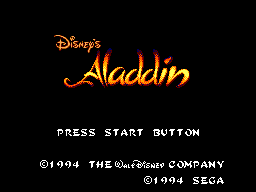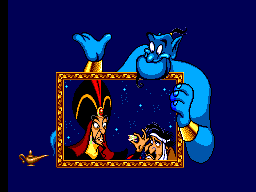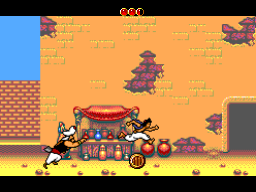
| Review Information | |||
| Reviewer Name: | Playgeneration | ||
| Game Difficulty: | Easy | ||
| Difficulty Options: | False | ||
| Game Information | |||
| Full Title: | Aladdin | ||
| Year Released: | 1994 | ||
| Game Type: | Platform | ||
| Max Players: | 1 | ||
| Introduction |
   |
||||||||||||||||||||||||||||||||||||
There have only ever been brief moments in gaming history when the words ‘Movie License’ didn’t make a game instantly dismissible as complete rubbish. These days developers bid against each other for the big names films, so end up spending a huge sum of money to attain the sole rights, leaving themselves with a tiny budget to actually make the game. But back in the early nineties this wasn’t the case, developers would get a license to make a game for a specific format. The most extreme example I can think of is Batman Returns which had completely different versions for Master System, Megadrive, Amiga, Snes, Nes and Lynx, that’s six different games from one license!. And since there were so many games all sharing the same name and competing for your money, developers had to put in a lot of effort to make their game stand out form the crowd. So on to the game in hand Aladdin based on thoroughly enjoyable Disney movie. The most well known and deservedly well loved version was from Virgin and released on Megadrive and Amiga. There was also a game developed by Capcom for Snes (also later ported to GBA) which is a good game, but couldn’t match the high watermark set by Virgins release. And last of all we have a version for our console of choice released by Sega themselves, not wanting to leave its die hard 8bit machine and its loyal fans miss out on such a popular Disney franchise. |
|||||||||||||||||||||||||||||||||||||
| Gameplay | |||||||||||||||||||||||||||||||||||||
The hugely popular Megadrive version is so well known, that it’s impossible to play the Master System game without making comparisons. Well just like the Megadrive release this version is predominantly a platform game, but it takes a far more simplistic approach. The first two levels see you purely running through Agrabah being chased by a guard and leaping over barrels and pits, its disappointingly easy and nothing like the intricate levels of the Megadrive game which saw you climbing ropes, engaging in sword fights and scaling tall buildings. By the third level thankfully the challenge and level design steps up a gear as you enter the cave of wonders, where you have to navigate your way past traps, search for keys to unlock passages, dodge falling rocks and other elements that actually require some skill to complete. There are a couple of levels where you ride upon the flying carpet, the first has you escaping the collapsing cave, dodging rocks and the glowing bubbling red hot lava, which looks particularly impressive I must add. Another flying level sees you taking Princess Jasmine on a carpet ride around the world, quite a romantic tone that you don’t usually see in a platform game, or any games for that matter. After your flying diversions there are a few more levels of puzzle based platform action in the palace, and for the first time in the game you can defend yourself by picking up the occasional stone and throwing them at the guard’s heads sending them into a daze. The final level where you confront the evil sorcerer Jafar mirrors the films climatic sequence almost perfectly, the developers obviously spent a lot of time watching the film and making sure that it was portrayed correctly. In between all the levels are lengthy cut-scenes that follow the plot of the film, all shown in full screen and using the same sprites as in-game which helps give the impression you’re playing an interactive cartoon. However they do drag on a bit too long, and unless you skip them you’ll actually spend longer watching them than playing the levels. |
|||||||||||||||||||||||||||||||||||||
| Graphics | |||||||||||||||||||||||||||||||||||||
This is easily one of the most impressive looking Master System titles, all the characters and levels look just like they do in the film, albeit a lot more blocky of course. Aladdin’s animation is a match for the much touted rotoscoped main character in Prince of Persia, every movement looks realistically lifelike. His hair even flops about as he walks, he waves his arms around when trying to balance, and there are so many other neat little touches. One particular part to look out for is when Aladdin throws his monkey Abu on to a guys face, it’s genuinely funny. Something you don’t usually see in a Master System game, and is therefore easily missed are the multi-layered animated backgrounds. For example in the very first level the buildings in the background have a 3D effect and rotate as you run past them, which is very impressive from a technical point of view on such limited hardware. You’d expect to see that sort of thing on a Snes which has clever stuff like sprite rotation built in to the hardware, so hats off to those clever programmers. The only fault with the graphics is that all of the characters have featureless faces, Aladdin’s lack of eyes, nose and mouth is a bit disturbing. |
|||||||||||||||||||||||||||||||||||||
| Sound & Music | |||||||||||||||||||||||||||||||||||||
Several of the famous Tunes from the film are featured throughout the game including ‘A whole new world’, and every rendition is surprisingly accurate. Sega really tapped the full potential of the Master Systems lowly sound chip this time. The sound effects are quite sparse, but the ones that are used all do their job perfectly. |
|||||||||||||||||||||||||||||||||||||
| Controls | |||||||||||||||||||||||||||||||||||||
Generally the controls are sloppy, getting pesky Aladdin to do what you what, when you want is not as easy as it could be. When you press the jump button there’s always a slight delay before Aladdin actually performs it. No matter how long you hold down the button Aladdin always jumps the same distance, which can lead to you accidentally leaping to your death if you’re not careful. When trying to jump up on to a ledge you have to press jump a small distance before it, so when you appear to be in the right place you miss completely which is often annoying. Double tapping either left or right is supposed to make Aladdin run in that direction instead of his usually leisurely walk, but it seems very unreliable and Aladdin often ends up stopping and starting instead. While these numerous control faults may sound frustrating they rarely are because the game is so easy anyway. |
|||||||||||||||||||||||||||||||||||||
| Replay Value |
|
||||||||||||||||||||||||||||||||||||
This is the major downfall of the game, as it features unlimited continues combined with only a few short levels you can complete it very quickly. There’s not much incentive to play it again either since there so little challenge. It seems the game was designed with young kids in mind, but id say it would be too easy for them too. If you had bought this game on release for £30 you would no doubt be pretty annoyed with its short playing time. If there were a couple of extra levels, and a set amount of lives for the whole game it would have had much greater replay value. |
|||||||||||||||||||||||||||||||||||||
| Conclusion | |||||||||||||||||||||||||||||||||||||
Games like Sonic proved that it was possible to make unique Master System versions that could match their bigger budget Megadrive counterparts, but on this occasion I think a port of the Megadrive game would have been preferable. The superb graphics and sound featured in this game prove that a conversion could have been possible. So what potentially could have been one of the Master Systems greatest triumphs is sadly just another pretty but unexciting platformer. |
|||||||||||||||||||||||||||||||||||||
Copyright © 2025 Sega8bit. All Rights Reserved.









